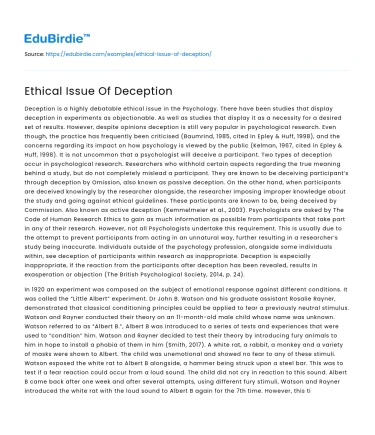Deception is a highly debatable ethical issue in the Psychology. There have been studies that display deception in experiments as objectionable. As well as studies that display it as a necessity for a desired set of results. However, despite opinions deception is still very popular in psychological research. Even though, the practice has frequently been criticised (Baumrind, 1985, cited in Epley & Huff, 1998), and the concerns regarding its impact on how psychology is viewed by the public (Kelman, 1967, cited in Epley & Huff, 1998). It is not uncommon that a psychologist will deceive a participant. Two types of deception occur in psychological research. Researchers who withhold certain aspects regarding the true meaning behind a study, but do not completely mislead a participant. They are known to be deceiving participant’s through deception by Omission, also known as passive deception. On the other hand, when participants are deceived knowingly by the researcher alongside, the researcher imposing improper knowledge about the study and going against ethical guidelines. These participants are known to be, being deceived by Commission. Also known as active deception (Kemmelmeier et al., 2003). Psychologists are asked by The Code of Human Research Ethics to gain as much information as possible from participants that take part in any of their research. However, not all Psychologists undertake this requirement. This is usually due to the attempt to prevent participants from acting in an unnatural way, further resulting in a researcher’s study being inaccurate. Individuals outside of the psychology profession, alongside some individuals within, see deception of participants within research as inappropriate. Deception is especially inappropriate, if the reaction from the participants after deception has been revealed, results in exasperation or objection (The British Psychological Society, 2014, p. 24).
In 1920 an experiment was composed on the subject of emotional response against different conditions. It was called the “Little Albert” experiment. Dr John B. Watson and his graduate assistant Rosalie Rayner, demonstrated that classical conditioning principles could be applied to fear a previously neutral stimulus. Watson and Rayner conducted their theory on an 11-month-old male child whose name was unknown. Watson referred to as “Albert B.”, Albert B was introduced to a series of tests and experiences that were used to “condition” him. Watson and Rayner decided to test their theory by introducing fury animals to him in hope to install a phobia of them in him (Smith, 2017). A white rat, a rabbit, a monkey and a variety of masks were shown to Albert. The child was unemotional and showed no fear to any of these stimuli. Watson exposed the white rat to Albert B alongside, a hammer being struck upon a steel bar. This was to test if a fear reaction could occur from a loud sound. The child did not cry in reaction to this sound. Albert B came back after one week and after several attempts, using different fury stimuli, Watson and Rayner introduced the white rat with the loud sound to Albert B again for the 7th time. However, this time the child paired the white rat with the loud sound and began to cry when the hammer was struck on the steel bar. Watson and Rayner introduced the other fury stimuli again, and as expected, Albert B’s fear had attached to the other fury stimuli (Watson & Rayner, 1920). Albert B’s fear transferred onto other fury stimuli, including “Rayners fur coat and Watson dressed in a Santa Claus Beard” (Cherry, 2019).
Save your time!
We can take care of your essay
- Proper editing and formatting
- Free revision, title page, and bibliography
- Flexible prices and money-back guarantee
Deception by commission was undertook in Watson and Rayner’s study. Unaware of participation was used, Albert B was just a baby, he was unable to personally give consent for his participation in the study. Alongside this, he was too young to understand the true meaning behind the study. However, it has been said that Albert B did have a Mother who received $1 for her “sons” participation in the study. Although, this theory has never been confirmed neither has her true identity. Watson and Rayner did not de-condition Albert B, this did not protect him from psychological harm as he was exposed to state fear (Essays, 2019). The American Psychological Association (APA) encourages all psychologists to avoid harm. This code of ethics was not recognised until 1953, 33 years after the “Little Albert” study was composed ('Little Albert Experiment', n.d.). The experiment unethical, psychologically dangerous and would not be able to be replicated today, although it would be very easy to do so (Shelton, n.d.).






 Stuck on your essay?
Stuck on your essay?

